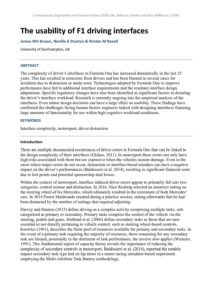| Document | Author James WH Brown, Neville A Stanton & Kirsten M Revell |
| Abstract The complexity of driver’s interfaces in Formula One has increased dramatically in the last 25 years. This has resulted in criticisms from drivers and has been blamed in several cases for accidents due to distraction or mode error. Technologies adopted by Formula One to improve performance have led to additional interface requirements and the resultant interface design adaptations. Specific regulatory changes have also been identified as significant factors in dictating the driver’s interface workload. Research is currently ongoing into the empirical analysis of the interfaces. Even minor design decisions can have a large effect on usability. These findings have confirmed the challenges facing human factors engineers tasked with designing interfaces featuring large amounts of functionality for use within high cognitive workload conditions. |

